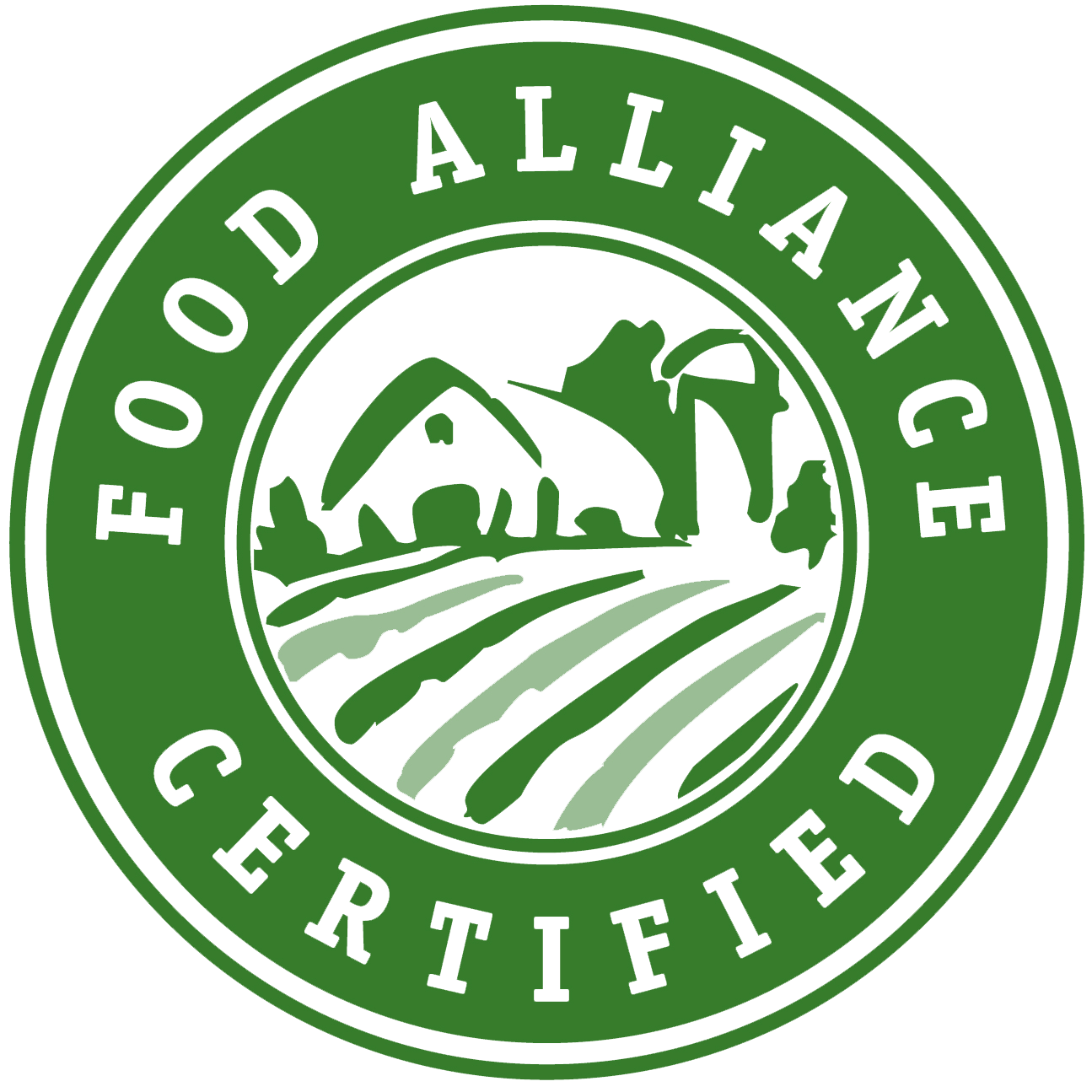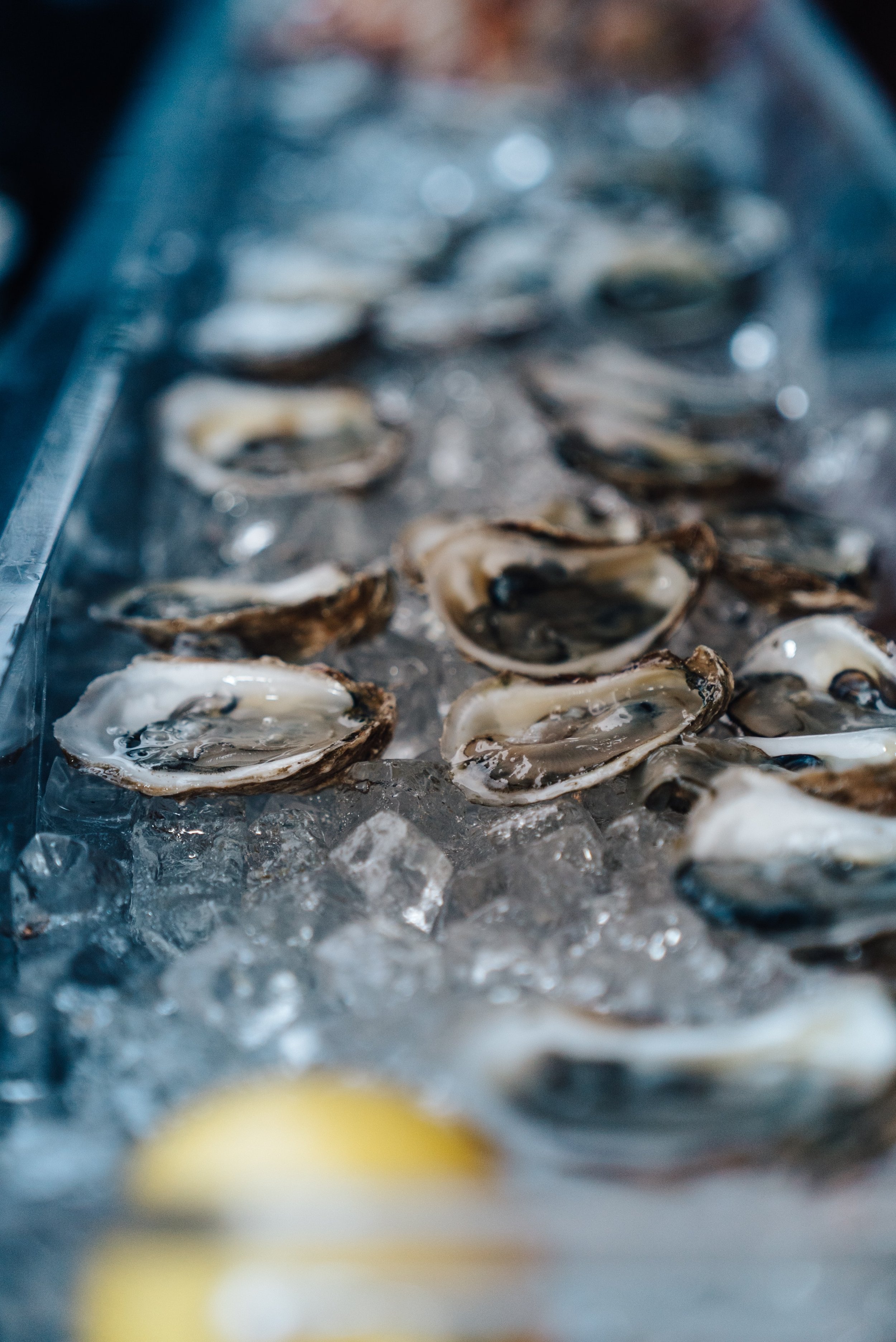Farmed Shellfish Operations
The standard applies to all North American production systems that produce shellfish from seed to harvest within a defined area and with clear ownership of the shellfish being cultured. It applies to shellfish farms that produce oysters, clams, mussels and geoducks. The standard does not cover wild harvest.
Getting Started
Food Alliance certification is a voluntary means for agricultural producers and food companies to address growing customer demand for traceability, transparency, and social and environmental responsibility. This page is specifically for farmed shellfish operations.
For producers interested in certification, they need to download and and review these documents:
Farmed Shellfish Certification Overview
Food Alliance Sustainability Standard for Farmed Shellfish
Evaluation Tools for Farmed Shellfish
Food Alliance Policy and Procedures Manual
What is the Food Alliance Sustainability Standard for Farmed Shellfish Operations?
The Food Alliance Sustainability Standard for Farmed Shellfish Operations addresses the following areas of concern:
Safe and fair working conditions,
Healthy, humane care for shellstock,
Integrated pest and weed management,
Soil and water conservation,
Fish and wildlife conservation, and,
Shared resource management.
Producers should review the Food Alliance Sustainability Standard for Farmed Shellfish, the Evaluation Tools for Farmed Shellfish, the Policy and Procedures manual, and the FAQs at the bottom of this page before applying for certification.
What are the Food Alliance Evaluation Tools for Farmed Shellfish?
The Food Alliance Evaluation Tools for Farmed Shellfish Operations describe criteria and indicators used to assess sustainability practices and outcomes. The Evaluation Tools have two purposes:
Growers may use the Evaluation Tool as a self-assessment to benchmark current management practices and sustainability performance.
Third-party inspectors will use the Evaluation Tool to determine if an operation meets the requirements of the Food Alliance Certification program.
What is the Food Alliance Policy and Procedures Manual?
The Food Alliance Policy and Procedures Manual lays out rules that govern the certification program.
Certification Process
Application > Site Inspection > Inspection Report > Certification
Step 1: Application
Shellfish producers interested in pursuing Food Alliance Certification should read the Food Alliance Sustainability Standard for Farmed Shellfish, the Evaluation Tool, and the Policy and Procedures Manual, and then complete an application.
To ensure your application is complete and reduce delays, please:
Answer all of the questions.
Sign the application documents where required.
Provide any necessary supporting documentation.
Include payment for the application fee.
The standard applies to all North American production systems that produce shellfish from seed to harvest within a defined area and with clear ownership of the shellfish being cultured. Farmed shellfish operations can download the application below.
Step 2: Site Inspection
Once your application is received and reviewed by Food Alliance, an inspector will contact you to schedule a site inspection. During the inspection, the inspector will tour the operation, interview managers and key staff, and review relevant records to evaluate performance using the Whole Shellfish and species specific inspection tools.
Step 3: Inspection Report
After the site visit, the inspector submits inspection reports (including all pertinent inspection tools) to Food Alliance.
Step 4: Certification Decision
Food Alliance reviews the site report and sends the applicant an inspection summary report listing their evaluation scores, and an inspection response form listing certification conditions (if issued) and suggestions for improvement. When the applicant’s responses are approved by Food Alliance, certification is granted and a certification letter issued. Once certification is granted, the Food Alliance Certified producer must maintain certification and use it to market their certified products.
Grievance Policy: If you feel that the site inspector’s findings are unfair or inaccurate, you may submit a request for re-evaluation to Food Alliance. A request must be made in writing within 30 days of receiving the official site report, detailing the perceived inaccuracies of the site inspection. Applicants should also state whether or not they would like to be inspected by a different site inspector. Re-inspections of this nature will be provided to you at no cost. No further appeals will be accepted. However, you may reapply after you have made changes to your operation as suggested in the site report.
Step 5: Maintaining Certification
Term of the Certification
The term of certification for shellfish producers is three years. The term of certification for processors and distributors is one year. The official start date will be specified in the certification letter along with the products that may be labeled as Food Alliance Certified.
Ongoing Compliance and Verification
This certification is designed to provide a basis for marketplace claims of environmental and social responsibility. In order to ensure the certification criteria are being met at all times:
Food Alliance reserves the right, at its own cost, to conduct unscheduled audits of participating farms, ranches, processors and distributors. Operations are either selected at random or based on specific concerns identified in the initial inspection.
Farmers and ranchers must also complete annual updates to maintain their certification, reporting any changes to their operation and progress towards their continual improvement goals.
Suspension and Revocation
If doubts are raised that an operation is not adhering to the certification standards, Food Alliance staff will investigate. If that investigation confirms the certification standards are not being met, that operation’s certification will be suspended. Food Alliance will provide the operation’s managers the reason(s) for suspension, specific steps for restoring certification, and a timeline for making the necessary changes. If the violation is remedied within the timeframe, certification will be restored. Otherwise, the certification will be revoked.
If you have any questions, or would like to receive these application forms in Word format by e-mail or a hard copy by mail, please contact our Certification Manager at (425) 466-7168 or certification@foodalliance.org.
Shellfish Certification FAQs
-
The Food Alliance Sustainability Standard for Farmed Shellfish Operations provides a comprehensive definition to guide oyster, clam, geoduck, and mussel farm operators in achieving greater sustainability outcomes. Performance to the standard is measured using the corresponding FA Sustainability Evaluation Tool for Farmed Shellfish Operations. The Evaluation Tool allows growers to self-assess current sustainability performance and set sustainability objectives – either as a prelude to certification or as a best management practice. Third-party inspectors use the Evaluation Tool to determine if an operation meets the requirements of the FA Sustainability Certification program for Farmed Shellfish Operations.
-
Food Alliance developed the Farmed Shellfish Standard in response to a request made by the Pacific Coast Shellfish Growers Association (PCSGA). In addition to the PCSGA’s Environmental Codes of Practice, some association members desired the marketing benefits of an independent certification. PCGSA is also concerned about competition with foreign shellfish growers, some of which operate with low environmental standards and under limited regulatory oversight.
-
The first step was to secure the necessary resources to create the standards, evaluation criteria and certification infrastructure. Food Alliance secured grants from the Keith Campbell Foundation, Wildlife Forever Fund, and the Russell Family Foundation for this purpose.
The shellfish evaluation criteria were developed in collaboration with Andrew D. Suhrbier, Senior Biologist with the Pacific Shellfish Institute, Olympia, WA.
The following individuals reviewed and provided comment on the evaluation criteria**:
Lisa Bishop, Little Skookum Shellfish
Colin Brannen, Aquaculture Program Officer, World Wildlife Fund;
Dan Cheney, Senior Scientist, Pacific Shellfish Institute;
John Finger, Hog Island Oyster Co.
Becky Goldburg, Director of Marine Science, Pew Environmental Group, Pew Charitable Trust;
Brian Kingzett, Blue Revolution Consulting Group;
Marco Pinchot, Community Relations and Sustainability Manager, Taylor Shellfish Co.;
John Lentz, Chelsea Farms, LLC.
Sandy Shumway, University of Connecticut, Department of Marine Sciences;
*Not all reviewer comments and suggestions were incorporated in the final draft of these evaluation criteria, so recognition of their contribution does not constitute an endorsement.
-
Practiced responsibly, shellfish aquaculture can itself be environmentally beneficial. Shellfish remove nitrogen, phosphate and other nutrients from the water as they feed. A single oyster can filter as much as 120 liters of water each day, and an acre of cultivated oysters can offset the nitrogenous wastes of 50 households. Shellfish also help offset carbon dioxide emissions by incorporating carbon in their shells.
Properly managed, shellfish aquaculture can also enhance habitat diversity, thereby benefiting a variety of organisms. Researchers have found that there is greater diversity and richness of species in sea beds with shellfish farming gear than in bare seabed or seabed habitat with eelgrass. Recent National Oceanic and Atmospheric Administration funded research found that mussel culture lines support more than 100 invertebrate species, and shiner perch and juvenile Pacific herring are seasonally concentrated in this habitat.
Tidelands that support shellfish aquaculture also provide critical foraging habitat for a large variety of water birds. Researchers have found that the population and diversity of 7 of 13 shorebirds and 3 of 4 wading birds was greater in tidelands with cultivated oyster beds.
However, shellfish aquaculture can also have negative environmental impacts. Identified risks include ecosystem integrity (with effects on surrounding habitat and the ecological community), disease and pest management (with potential for disease and pest transfer, pathogen loading, and use of chemical treatments), waste management (with lost gear and related debris, chemicals, and organic waste; processing of wastes; treatment of effluent; and maintenance of equipment), and multi-use issues (location, development, and aesthetics of aquaculture sites and conflicts with other resource users).
-
Food Alliance certified producers make informed decisions regarding pest management and pesticide use. They employ cultural and biological pest prevention strategies to reduce or eliminate the need for pesticide applications. When pesticides are needed, they select effective materials with the fewest known environmental and health hazards for appropriate pest control outcomes. Food Alliance producers properly maintain application equipment to ensure precise applications and monitor weather conditions to prevent pesticide drift. When combined, these practices create an Integrated Pest Management strategy adapted to local conditions. As such, Food Alliance producers are able to deliver economically effective pest control while minimizing negative impacts to human health and the environment.
Food Alliance recognizes that there are some circumstances under which producers may not have complete management control over pest management on their operations. Where local, regional, state or federal regulations require producers to comply with pest management programs, e.g. invasive species management, Food Alliance will make allowances for applications that fall outside the Food Alliance standards.
Food Alliance certified shellfish farmers whose farms include upland areas are evaluated using criteria similar to those applied to terrestrial producers. Aquatic applications of pesticides are not allowed except as legally required, e.g. control of Spartina, an invasive species.
Food Alliance makes a temporary exception for the aquatic application of pesticides to control burrowing shrimp in Willapa Bay, WA and Grays Harbor, WA. Shellfish producers in these locations currently are allowed to spray carbaryl in restricted areas under a strict IPM guideline.
-
Food Alliance certification best suits producers and handlers who:
Actively manage their operations with environmental and community impacts in mind,
Have a commitment to continually strive to innovate and do better, and
Wish to differentiate their company and its products in the marketplace through thoughtful marketing that highlights their sustainable practices.
Producers and handlers should understand that certification is a tool that supports their brand and marketing claims with independent verification their operation meets a meaningful, stakeholder reviewed, openly published standard for sustainability.
-
A Food Alliance inspection is required for any shellfish packing or processing facility (“handling” facility) preparing and selling Food Alliance Certified products. Handling facilities that change the form of live shellfish (i.e. shucking, smoking, cooking) must apply for Food Alliance’s handling operation program and achieve either Food Alliance handler certification or restricted handler approval. These shellfish handlers must undergo a similar process as producers. The Handler manual and application materials can be found here.
If a shellfish handling facility is simply cleaning and packaging the live product, and it has a traceability and labeling system in place that ensures commingling of Food Alliance Certified and non-certified products does not occur, inspection of that facility may be included as part of the farm inspection and a separate handling operation application and inspection is NOT required. For more information, contact Food Alliance at info@foodalliance.org.
-
For Farmed Shellfish Operations there are two types of fees: inspection fees and licensing fees.
Inspection Fees
A payment of $800 is due with the application. This includes a non-refundable $400 document processing charge and a $400 deposit towards the actual cost of the inspection.
The processing charge covers review of applications, coordination of the inspection, review of inspection reports, and the recommendation for certification.
Inspection costs include inspector time and travel expenses, which may vary depending upon the location, number of facilities, number of production lines, etc. The balance for inspection costs is invoiced upon completion of the inspection and is payable in 30 days.
The total to inspect a shellfish production site averages around $1,200. Food Alliance certification is valid for 3 years, so you can think about the pro-rated cost for inspection fees being $400 per year.
On request, Food Alliance can provide an estimate for the cost of inspection before you submit your application for certification, based on your location and the size and complexity of the operation.
Licensing Fees
Gross Sales Licensing Percentage
First $150,000 0.4% or $200 minimum
Next $150,000 0.2%
Additional Sales. 0.1$
Members of cooperatives and producer groups who jointly market products pay licensing fees using the same fee schedule as independent producers. However, these groups aggregate all sales when calculating licensing fees.
-
The group must submit an estimate of annual gross sales of products to be certified.
The group must identify all of the farm and ranch members who will be providing certified products for sale.
Food Alliance must receive completed certification applications and the above fee for each of the appropriate members.
Producers growing for contracts which require Food Alliance certification pay the inspection fees described above, but pay a licensing fee based only on the value of goods sold under that contract (not gross sales of the products). Contract producers must meet all Food Alliance criteria for the product in question, but are not allowed to label products or assert Food Alliance certification claims about products outside of the specifying contract.
Shellfish Handling Facilities
Food Alliance certified handling facilities are subject to an at-cost annual inspection fee (which may vary depending upon location, number of facilities, number of production lines, etc.), and annual licensing fees based on sales of Food Alliance certified product(s).
-
In the United States, shellfish farming is already governed under the National Shellfish Sanitation Program. These standards include regular monitoring for fecal coliform bacteria (as an indicator for potential pathogens in the water), vibrio diseases, harmful algal toxins, heavy metals and other contaminants.
As a sustainable agriculture certification, Food Alliance challenges certified businesses to assess and manage a wide variety of risks to human and environmental health. A number of the certification criteria, such as the expectation that workers have access to sanitary restrooms and hand-washing facilities, contribute directly to food safety. Many others, such as criteria designed to prevent wastes or chemicals from entering the water supply, serve human and environmental health more broadly.
In addition to certifying producers, Food Alliance also certifies food handling operations – including packers, processors and distributors. That certification process includes verification that handlers have plans and programs in place to help ensure food safety.
-
Food Alliance was the first to offer certification for farmed bivalves (oysters, clams, geoducks, mussels) in North America – but there are now other programs to consider.
The Aquaculture Stewardship Council (ASC) has completed its standards setting process and agencies such as Scientific Certification Systems have been accredited to conduct certifications.
On the surface, Food Alliance and ASC standards appear to cover a similar set of issues. However, it is important to understand that Food Alliance’s standards were written for implementation exclusively in North America. The ASC standards were written to provide an industry baseline worldwide – including in third-world contexts where there may not be adequate regulation or enforcement.
We believe that Food Alliance sets a higher and more meaningful standard for farmed shellfish, and for markets in North America can help distinguish domestically produced shellfish from imports.
Food Alliance’s inspection and licensing fees for farmed shellfish certification are also reportedly significantly lower than the cost for ASC certification.
-
The Monterey Bay Aquarium’s Seafood Watch list is a valuable tool that helps restaurants, retailers, and consumers make seafood purchase decisions. Seafood Watch rates farmed shellfish worldwide as a “Best Choice” and says “Farmed oysters account for 95 percent of the world’s total oyster consumption. Most oyster farming operations are very well managed and produce a sustainable product.”
However, Seafood Watch does not assess or certify the sustainability of individual suppliers. Food Alliance is an independent, non-profit organization that goes beyond general species or production/harvest method recommendations to distinguish well-managed shellfish farming operations so that managers can further differentiate and add value to their products in the marketplace. This may be particularly beneficial for domestic producers competing with international suppliers that may not be held to the same regulatory or industry practice expectations.




